IBM Think Center S50: The Ideal Corporate Small Form Factor
by Wesley Fink on October 21, 2003 10:55 PM EST- Posted in
- Systems
IBM Think Center S50: S50 Chassis
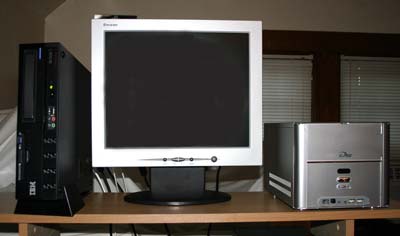
IBM's Think Center S50 is the smallest Desktop PC made by IBM — some 62% smaller than traditional IBM Desktops. As you can see in comparison to the more traditional SFF, the Think Center is laid out as a wide, thin, and shallow computer. At 12.2" x 14" x 3.3", it is really quite small. Despite the size, the S50 is very heavy, weighing a bit over 16 lbs. (7.3 kg). IBM claims that the S50 can support heavy CRT monitors on top of the unit, and we agree — you will not find any thin metal in this computer. In addition, the thick metal is said to function as a heatsink, keeping the Think Center cooler. The S50 is all black and comes with a matching black keyboard and mouse.
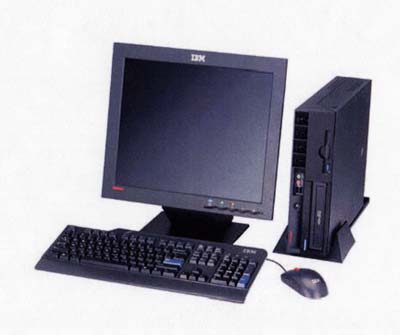
A tilt-stand is also provided, which reduces the “footprint” even further. In the system above, the S50 is standing next to a 17" flat panel. Even in the smallest cubicles and on the smallest desk, the IBM is kind in its space requirements.

The Think Center front has slanted air intakes where 2 small, but quiet, fans pull in outside air to cool the fanless CPU. Standard components are a 1.4mb 3.5" floppy and a CD-ROM, CD-RW or DVD-ROM. Either a 40GB or 80GB 7200RPM hard drive is available. In addition to drive access, the front has 2 USB 2.0 ports and mic and headphone inputs. A flush on/off push-button is also on the front of the tiny chassis.

The rear of the chassis is a pleasant surprise in terms of port selection. Not only are there six USB 2.0 ports on the rear, you will also find 2 serial ports and a Parallel port — very unusual on SFF computers. Anyone who has worked in the Corporate Computer arena will quickly discover that there are lots of legacy peripherals to which corporations have become attached, and these sometimes are proprietary. IBM was smart to cater to those needs with a full array of legacy ports plus a full 8 USB 2.0.
If you are looking for the Firewire ports, you won't find any. This machine is targeted at the Corporate desktop, and it is very rare to find a consistent need for IEEE 1394 ports in that target audience. Since there are 2 PCI expansion slots in the PC, a Firewire card can always be added if needed.
You can also see the outlet grill on the rear for the 200 Watt power supply. IBM has paid careful attention to the PS, selecting a model that is very quiet.

The small black IBM box is a model of simplicity from an end-user's perspective. The computer is completely screwless. A top key lock can prevent unauthorized access to the unit. There is also a Kensington lock slot for Corporations using that security solution.

Opening the computer is as easy as pushing the lock buttons on each side and raising the top. Inside, you will find an open, uncluttered interior whose excellent engineering makes it appear to be the model of simplicity.
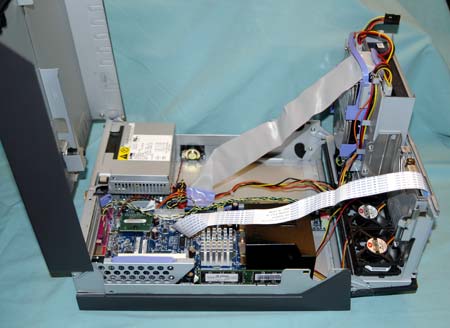
By flipping out the hinged drive panel, you have full access to everything inside the computer. IBM markets the Think Center S50 as extremely easy to service. More than that, many corporations will consider the S50 as User Serviceable to much deeper levels than generally seen on the Corporate desktop. Of course, this significantly reduces “cost-of-ownership” over the 2- to 3-year lease life of the S50.
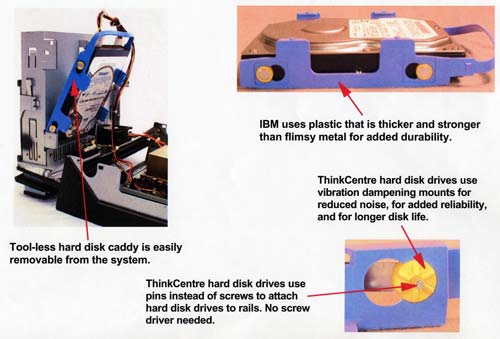
Even the drives in the S50 are “User-Serviceable”. The drives can be removed or replaced without so much as a screwdriver. Whether replacement is by the actual PC user or a technician, service time is significantly reduced for drive replacement.
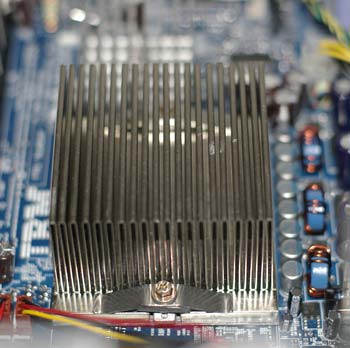
The CPU is protected by a metal cover. Beneath the cover is a very large passive heatsink generally preferred by IT departments. Cooling air blows across the heatsink fins from the 2 front mounted fans to allow high-end CPUs to be used. Our test system came equipped with a 3.2GHz Pentium 4.

The Think Center S50 provides 2 full-length PCI slots for expansion. The lack of an AGP slot reminds us again that the target audience is the Corporate Desktop. Corporate PC departments would not be adding expensive 8X AGP cards to computers aimed at general business usage, and the on-board Intel Extreme Graphics 2 is plenty of graphics power for business applications.










20 Comments
View All Comments
mindless1 - Sunday, February 8, 2004 - link
It's a shame the article uses proprietary SWF images, instead of the industry standard formats which everyone can use. Is the author getting kickbacks from Macromedia?Budman - Wednesday, November 5, 2003 - link
asdadadUtterman - Friday, October 24, 2003 - link
I have deployed around 1500 IBM thinkcentre S50's nationwide and they are really great systems to work with. Out of the 1500 systems that I worked with, I only had problems with 5 of them. This review is pretty dead on with everything about the S50. I find they are great systems to use for an office environment, but anything that needs a lot of performance prob. should look at something higher end.Shalmanese - Thursday, October 23, 2003 - link
It has always been my private opinion that Content creation is only related to typical buisness usage in that it has the same range of applications. However, saying that a 10% difference in content creation will translate into a 10% difference in real world buisness usage is like saying a 50% increase in memory bandwidth will lead to a correspondingly large increase in bandwidth intensive applications. The dillema is that any benchmarking utility that simulated TRUE desktop performance would be of no use as a benchmarking utility. Over the span of an 8 hour workday, the difference between a fast and slow computer may be 30 seconds worth of extra wait time if that. Also, the S50 is offered at every speed from a 2Ghz Celeron to a 3.2Ghz P4. Obviously, they would ship you the most expensive model to review but the vast majority sold are going to be in the mid range.Anonymous User - Wednesday, October 22, 2003 - link
The lack of CPU cooling fan concerns me. I've got a couple hundred SFF Dell OptiPlex machines throughout my office and I sleep better knowing the CPU has its own active cooling. Too many machines are shoved into areas that don't provide enough airflow for effective convection cooling, and we all know what that eventually leads to.And as for the 2-3 year lease deals, I think one of the good things to come out of the "dot bomb" era is that companies are demanding more from their equipment. Short-term lifespans may be great for the business models of technology companies but those of use in old-economy industries have a different idea of what a machine's expected lifespan should be. Mind you we're not using Commodore 64s for anything, but a four-year-old P3/500 runs Windows 2000 and MS Office just fine for your typical office worker. And that is where a business-oriented machine really shines- it's much easier to keep a fleet of old OptiPlexes or HP Vectras running smoothly than a hodge-podge of no-name machines.
sprockkets - Wednesday, October 22, 2003 - link
The only thing I care about is how a stupid 3.2ghz 82 watt minimum processor can be cooled with such a dinky heatsink and quiet small fans. It like all other OEM cooled processors run at around 80c. They won't let you see the temperature for obvious reasons, since while a processor can run at 80c it will last much longer at cooler temps. And if you want stability you need to keep stuff cool.Also a 3db increase in sound is not twice as loud. A 10db increase is. But that doesn't take into perception of how annoying something can sound. For instance, a computer I have at home is just a little wider than a pci slot, so it has it's cd-rw drive vertically. The ps fan on it is on the outside and is only 60mm and 10mm thick. It gets very loud due to it getting rid of the heat in the system. In fact, it's loud whether I have a 800mhz duron or 1800+ Tbred. But then I took it to a reception hall and put it on stage I could barely tell it was on. So while it may sound quiet in a open building in a business, it will sound very loud at home. But that's just me and one observation.
Anonymous User - Wednesday, October 22, 2003 - link
Interesting review. I just picked-up a stack of Small Forms for my company…the IBM small form was one I rejected, basically because it looks so bad….amongst other rejected systems including HP/Compaq, Dell(which is now absolutely prohibited from conducting business with my company – different story) and Micron.I ended up, at $600.00 per machine, with Gateway E4100s. Celeron 2.4s with 256 dual-channel DDR, Intel MoBo and basically the same chassis….only not as tacky looking as the IBMs. They’re also completely silent.
Anonymous User - Wednesday, October 22, 2003 - link
I implement machines for small to mid-size companies in the Pacific Northwest. My recommendation and what I am hearing in the field is that there is very little need to renew leases from 2-3 years ago. User's themselves are seeing little to no benefit for getting the latest and greatest. People want their jobs, not more PC's brought in. There really aren't many apps that take advantage of the speed for most cases. People aren't rendering here or playing games, folks.Having said that we buy mostly small form factor PC's, and we buy mosltly HP. We used to buy Dell but saw their support go absolutely downhill in the last 2 years. Without Support why buy from these companies at all? Anyway, now we're just considering getting shuttles or vanilla brand. The only parts that really fail anymore are HDD's (and do they ever fail, the failure rate is about 10% easy across all manufacturer's of IDE, which is a lot)
We can save a customer roughly $200-$300 by just getting no-name brand boxes like shuttle, etc, over IBM/HP. It's something we're seriously considering.
Anonymous User - Wednesday, October 22, 2003 - link
Regarding the mysterious lower performance of the IBM S50, I think the clue must be the memory speed because 320MHz memory is bizarre when dual 400MHz is the design for this processor. This means one of two things...1) Asynchronous mode - if the S50 uses asynchronous memory timing, we all know that this reduces performance. We've seen many tests where 266 MHz synchronous is faster than 333MHz asynchronous. Also, to my knowledge, the P4 3.2 is made for dual channel 400MHz (800MHz effective) so running a 320MHz DIMM in single channel (320MHz) or dual channel (640MHz) mode WILL DEFINITELY hurt performance since the long pipelines in the P4 and the very high 3.2GHz speed are very dependent on avoiding any kind of wait on memory (a lower speed P4 such as 2GHz would be affected less). If true, this would be a double oversight.
OR
2) Synchronous mode - if the S50 uses dual channel memory in synchronous mode and they limit the speed of each bank to 320 MHz, then the fixed multiplier of the CPU must result in an actual CPU clock speed of 2.56 GHz rather than 3.20 GHz. If true, this is a simple case of underclocking.
Either way this is a strange decision by IBM.
--charlesz (waiting on my AnandTech password).
Wesley Fink - Wednesday, October 22, 2003 - link
As stated in the review, stability and trouble-free operation are MUCH more important to IT Departments than performance will ever be. We did not test the IBM S50 as we would an Enthusiast machine since that is not appropriate. In fact, we ONLY ran Content Creation and General Usage benchmarks because these are made up of the kinds of applications Corporations normally use on their desktops. The IBM was at least 10 to 20% slower in those benchmarks than any other 865/865G we have tested. That is significant enough that we think it WILL interest some, if not all, IT departments.The IBM deserves the praise we gave on Engineering and low noise levels, but someone should be questioning the dismal performance we found in Corporate applications suites. If my IT department specified 3.2GHz P4s I would certainly expect to see performance in that neighborhood, and not performance more typical of a 2.6GHz CPU.